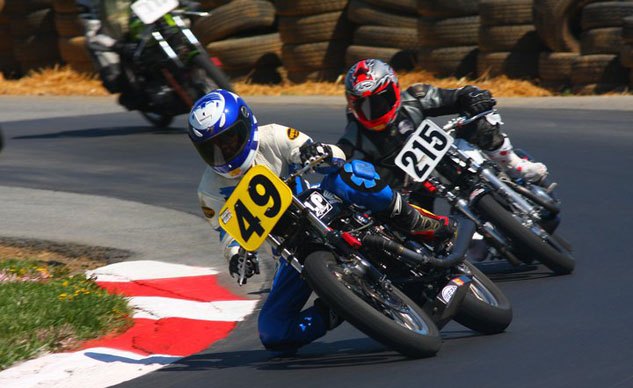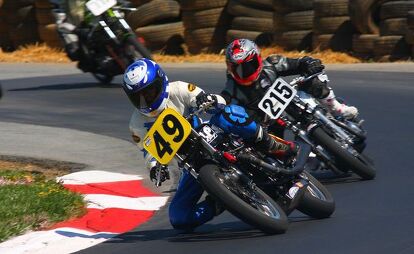Head Shake - Yesterday's Fast
.And Today's Affordable Racing
There has been a quiet evolution taking place that I believe is making roadracing opportunities more broadly available to a wider audience. This is good for both aspiring novice racers who seek to acquire their license and some seat time, as well as veteran go-fast guys who have a bike loitering around in the garage all safety-wired up with number plates getting dusty. A quick glance at the WERA rulebook, Chapter 11, Vintage Rules, would give you a hint. The notion of what constitutes “Vintage” has changed over time, and particularly in the past year.
When you say vintage racing to many people, it evokes images of hand-shift Harleys and BSA Gold Stars. The more savvy may mutter something about XS650s, RD350s, and CB350s, and they’d all be right. But how about RC51s, Ducati 748s and 916s, CBR600F3s, in short, depending upon class and exemptions, bikes that are as recent as 12 years old, maybe newer. For example:
Vintage 8 Mediumweight: Machines based on C Superbike rules that are 12 years old or older based on the current season year as well as the exact same model of a newer year but unchanged in every way other than graphics –WERA Rulebook, Chapter 11, Vintage Rules.
The addition of Vintage 8 Mediumweight provides another avenue for novice racers, many of whom in the past had flocked to the C Superstock and Superbike ranks on older and less competitive machines. With a class of their own structured with their bikes in mind, they might get close enough to the front to climb atop the podium while simultaneously reducing their upfront costs. There are bushel loads of both race-prepped and road-going 12-year-old 600s that would be perfect for the job. To the extent that it thins the C Super grids for riders on older bikes in favor of Vintage 8 Mediumweight, I can only think of that as enhancing safety. If it brings more would-be racers into the track, overall numbers should grow which can only be good for racing. And you can always bump up to the modern classes if you are the overachieving type. It’s a win-win-win for everybody. And for veteran racers with a 600 Supersport bike gathering dust? They just got a gift, another class to run.
None of these changes take anything away from what were the previous Vintage classes or the characteristics that made vintage racing attractive in the first place. There is still a place for your Triumph Trident or your punched out 1058cc Z1. But consider the other benefits, both new and longstanding.
Racers have always been helpful animals. If you crash, or your bike won’t run, chances are real good you’ll have somebody or three in your pit from your class trying to get your bike back together so you can make your grid. If racers form a tight community, the vintage bunch is positively clannish. Everything from where to source parts, to providing offseason help in a bike build, to finding the right ride for you, they are there for each other. Some of it is self-serving in a good way, they are racers, they need people to race against. If you don’t make the grid that is one less bike to dice with on the track. Race long enough and I bet you will develop friendships that will last a lifetime.
It’s not just the evolution of Vintage 7 and Vintage 8 that has made racing more affordable and accessible, many of the classes from Vintage 1 and 350 GP on up are as cheap or as expensive as you want to make them. There is literally a class for every budget. The bikes can range from the ultra trick and museum worthy, to salvage title sportbikes of the Jamie James era cobbled together with plastic and parts from half a dozen donor bikes. You can go as unobtainium or inexpensive as you want, it’s up to you.
Tire warmers? Who needs them (in many of the classes)? Tires don’t just last a race weekend, they last a season (in some classes). And in the smaller-displacement classes, the bikes crash well, as in, you are not replacing bodywork and eating popcorn and beans for the next month. Fall down and go boom and you may find yourself replacing a clip-on or a control lever, but it won’t turn you into Team MasterCard. Not only is the cost of entry cheap – relatively speaking equipment-wise – crashing is cheap! How can you beat that?
Vintage Expert and Novice racers are scored the same, unlike the modern classes which break out Novice and Expert results. If you are a new racer you may be thinking, “Hey, hang on a second, that means I have to get by the experts to get to the front and get on the podium!” Well, yeah, it does mean that, but it also means that, by and large, the guys on the track with you have years of experience, likely have no illusions that they are going to be the next MotoGP phenom, and are unlikely to do anything squirrelly and put you on your head. You also have a level playing field competing against similar equipment. I’d say that’s a pretty good trade, and besides, chasing the experts will make you a better racer.
I have been going on about WERA because the bulk of my experience has been with them going back to 1985, and I’ve always thought highly of their leadership. I’d also encourage any new aspiring racer to seek out any other sanctioning organization in their region. You don’t have to marry any one organization, but WERA in general, and WERA Grand Poobah Sean P. Clarke in particular, have always been responsive to the vintage community in soliciting rule change proposals to be considered in the offseason. This seems like a sound way to run an organization. If these new classes and class definitions make sense, the reason is simple; they came from the racing community itself.
Racing is racing, the satisfaction and challenge that comes from running a close race is the same whether you are running modern classes or vintage classes. When I started in 1985, I paid little attention to the vintage classes aside from hoping they wouldn’t grenade on the front straight and puke the contents of their motors on the racing line. Times have changed. With the expansion of what constitutes “vintage,” the opportunity to grid up is more affordable, and more broadly available, than ever before.
If you are curious, or you want to take a peek behind the door, go check in on the inmates at the WERA Vintage message board. If you have any questions, the speed-addled loons on that forum are obscenely helpful, very knowledgeable, and endlessly entertaining.
If you would like to see where your bike might fit in or what class you might want to compete in, check out Chapter 11 of the WERA Rulebook.
Go forth, have fun, be safe, and when that one-minute board goes sideways? Leave … quickly. I hope to see you on top of the box! Good luck!
About the Author: Chris Kallfelz is an orphaned Irish Catholic German Jew from a broken home with distinctly Buddhist tendencies. He hasn’t got the sense God gave seafood. Nice women seem to like him on occasion, for which he is eternally thankful, and he wrecks cars, badly, which is why bikes make sense. He doesn’t wreck bikes, unless they are on a track in closed course competition, and then all bets are off. He can hold a reasonable dinner conversation, eats with his mouth closed, and quotes Blaise Pascal when he’s not trying to high-side something for a five-dollar trophy. He’s been educated everywhere, and can ride bikes, commercial airliners and main battle tanks.
More by Chris Kallfelz




































Comments
Join the conversation
Chris! I thought you were gone forever after Ron, Fernando and I lost you in that Chicago pub back in "96". Glad to see you on these pages!!
One of the best races I ever had was a vintage event. I had my 1980 TZ250 running against a late '70's Suzuki 1000. Where one was fast, the other wasn't. It was great!